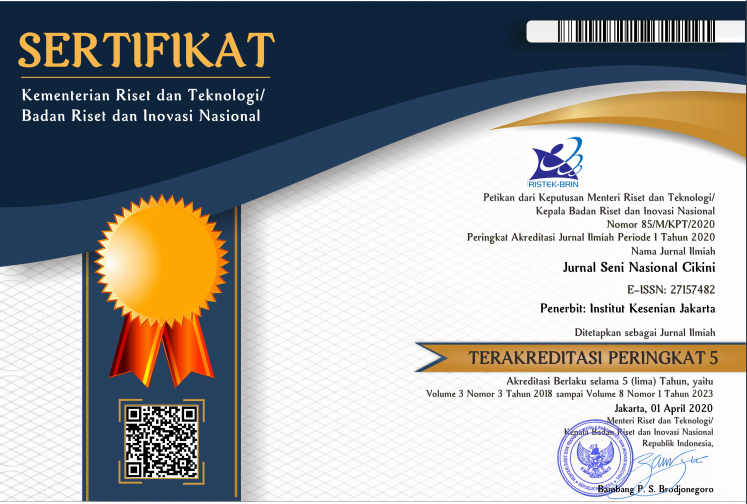Tinjauan Literatur: Tato Sebagai Media Narasi Perempuan
Abstract
Artikel ini merupakan ulasan literatur dalam bentuk artikel jurnal dan buku dari penelitian mengenai perempuan bertato dan bagaimana tato dapat menjadi media narasi bagi mereka. Dari sejumlah artikel jurnal dan buku yang ditelaah oleh penulis, tampak bahwa budaya patriarki menciptakan tolak ukur kelaikan seseorang secara fisik, terutama perempuan. Standar-standar tersebut memosisikan perempuan sebagai penanggung beban dari nilai-nilai patriarkal yang dikenakan atasnya hingga sulit bagi mereka untuk dapat memproses dan mengekspresikan pengalaman emosionalnya tanpa mengalami emosi negatif, sebagaimana yang dipaparkan oleh Cixous dalam “The Laugh of Medusa” (1976). Tinjauan literatur ini ditulis menggunakan teori penulisan perempuan oleh Cixous sebagai cara pandang terhadap tato yang dikenakan perempuan sebagai salah satu wujud dari tulisan yang mereka buat.
References
Armstrong, M. (1991). Career-oriented Women with Tattoos. Image--The Journal of Nursing Scholarship, 23, 215-220. doi:10.1111/j.1547-5069.1991.tb00674.x
Bach, D. (2013). Women opt for tattoos after mastectomy. Retrieved from https://www.fredhutch.org/en/news/
center-news/2013/11/tattoos-after-mastectomy.html
Burns, B. (2016). Mother to Other: Feminine Becoming in Fiona McGregor’s Indelible Ink. Antipodes, 30, 71. doi:10.13110/antipodes.30.1.0071
Buss, L., & Hodges, K. (2017). Marked: Tattoo as an Expression of Psyche. Psychological Perspectives, 60(1), 4-38. doi:10.1080/00332925.2017.1282251
Butler, J. (1988). Performative acts and gender constitution: An essay in phenomenology and feminist theory.
Theatre Journal, 519--531.
Cixous, H., Cohen, K., & Cohen, P. (1976). The Laugh of the Medusa. Signs: Journal of Women in Culture and Society, 1(4), 875-893. doi:10.1086/493306
Eason, K. A., & Hodges, N. (2011). Reading Contemporary Female Body Modification as a Site of Cixous' L'ecriture Feminine. Fashion Theory, 15(3), 323-343. doi:10.2752/175174111X13028583328847
Fisher, J. A. (2002). Tattooing the Body, Marking Culture. Body & Society, 8(4), 91-107. doi:10.1177/1357034X02008004005
Hardin, M. (1999). Mar(k)ing the Objected Body: A Reading of Contemporary Female Tattooing.
Fashion Theory, 3(1), 81-108. doi:10.2752/136270499779165734
Kang, M., & Jones, K. (2007). Why do People get Tattoos? Contexts, 6(1), 42-47. doi:10.1525/ctx.2007.6.1.42
Kosut, M. (2015). Tattoos and Body Modification.
International Encyclopedia of the Social & Behavioral Sciences, 2nd edition, 24, pp. 32–38. doi:10.1016/B978-0-08-097086-8.64027-8
Leader, K. (2016). "On the book of my body": Women, Power, and "Tattoo Culture". Feminist Formations, 28(3),
-195. Retrieved from https://www.proquest.com/docview/1866465508?accountid=17242 Locke, K. (2013).
Women choose body art over reconstruction after cancer battle. Retrieved from https://www.theguardian.com/society/2013/ aug/07/mastectomy-tattoo-breast-cancer Mun, J. M., Janigo, K. A., & Johnson, K. K. P. (2012). Tattoo and the Self. Clothing and Textiles Research Journal, 30(2), 134-148. doi:10.1177/0887302x12449200
Munaf, Y., Gani, E., Rosa, A., & Nura, A. (2001). Kajian Semiotik dan Mitologis terhadap Tato Masyarakat Tradisional Kepulauan Mentawai (H. Indiyati & R. Ekoyanantiasih Eds.). Jakarta: Pusat Bahasa Departemen Pendidikan Nasional.
Nadia, I. F., Nelson, K. C., Sawitri, & Widyawati, R. (2007).
Women’s Human Rights Monitoring Report
GENDER-BASED CRIMES AGAINST HUMANITY: LISTENING TO THE VOICES OF
WOMEN SURVIVORS OF 1965. Jakarta : Komisi Nasional Anti Kekerasan Terhadap Perempuan Nash, M. (2018).
From ‘Tramp Stamps’ to Traditional Sleeves: A Feminist Autobiographical Account of Tattoos. Australian Feminist Studies, 33(97), 362-383. doi:10.1080/08164649.2018.1542591
Neuman, W. L. (2014). Social Research Methods Qualitative and Quantitative Approaches: Pearson.
Strübel, J., & Jones, D. (2017). Painted Bodies: Representing the Self and Reclaiming the Body through Tattoos.
The Journal of Popular Culture, 50(6), 1230-1253. doi:10.1111/jpcu.12626
Wasarhaley, N. E., & Vilk, R. F. (2020). More Than Skin Deep? The Effect of Visible Tattoos on the Perceived Characteristics of a Rape Victim. Women & Criminal Justice, 30(2), 106-125. doi:10.1080/08974454.2019.1613283
Wilson, S. E. (2008). Marks of Identity: The Performance of Tattoos Among Women In Contemporary American Society. (Master of Arts). University of Maryland,
Wohlrab, S., Stahl, J., & Kappeler, P. (2007). Modifying the body:
Motivations for getting tattooed and pierced. Body image, 4, 87-95. doi:10.1016/j.bodyim.2006.12.001
Copyright (c) 2021 Jurnal Seni Nasional Cikini

This work is licensed under a Creative Commons Attribution-NonCommercial 4.0 International License.





